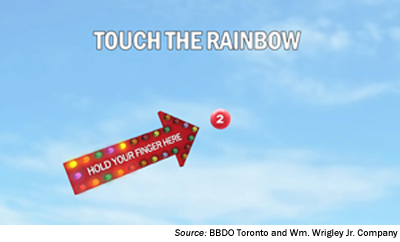Activity 5: Your understanding of moving images (interactive ads)
Activity 5: Your understanding of moving images (interactive ads)
Most moving images we see are not interactive. That is, we watch them or somewhat passively receive the content. Some artists and advertisements, however, have thought a bit more creatively and innovatively about inspiring interaction with moving images.
Click Submit after the text box to submit your answers to your instructor’s gradebook. You may review your answers by returning to this activity at any time. (An activity reports to the gradebook only if your instructor has assigned it.)
The following still images are from a Skittles online ad campaign. In each of the ads, the viewer is invited to place his or her finger on the screen, at the spot indicated by the candy. The moving image that then plays is interactive with the viewer’s finger. Do a Web search to find other ads from this campaign. What difference does the interactivity make? How does the ad feel different, or how do you respond differently to it, because of its interactive nature?


Source: Images used with permission from Wm. Wrigley Jr. Company. © 2011. All rights reserved. SKITTLES, the S Device, and all affiliated designs are trademarks of Wm. Wrigley Jr. Company or its affiliates.
Question
46O/GvlXlao=Go to related section: Analyzing moving images